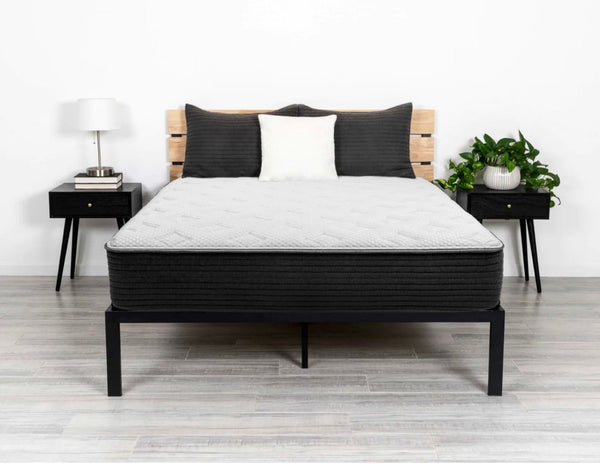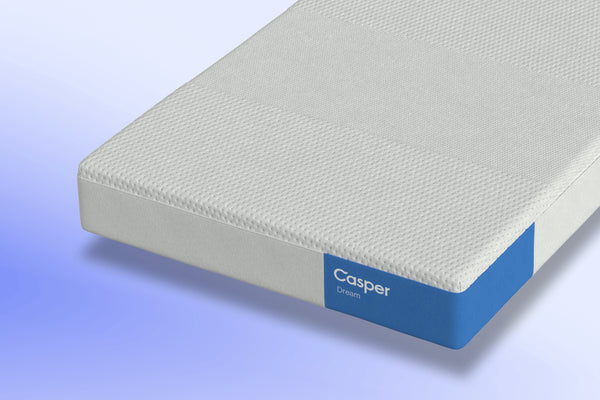
A mattress designed specifically to meet the needs of hot sleepers should feature breathable materials that encourage airflow to reduce overheating – something often experienced when sleeping hot.
Hybrid and innerspring mattresses tend to sleep cooler due to their coil construction which allows more airflow than basic memory foam layers. Many manufacturers also add cooling technology into their mattress layers.
Hybrid and innerspring mattresses
Many hybrid mattresses utilize latex or poly foam layers that provide cushioning and support, with latex being preferred over poly foam due to its greater breathability and low sleeping heat levels. Such mattresses may be perfect for most people. But you should still ensure the manufacturer has taken steps to prevent overheating; such as creating more open-celled structures, adding air holes in foams, or using cooling covers.
Innerspring mattresses are another popular choice. These multilayer beds typically feature different coil gauges, counts and patterns to offer different levels of support; depending on the maker and model they may also include reinforced edges or targeted support zones for optimal results. In general, innersprings tend to outlive all-foam mattresses due to their durability.
Although these beds provide excellent support, they can be more expensive than other mattresses. Furthermore, these beds may cause motion isolation issues for couples sharing a bed. In addition to that, these heavy and difficult-to-maneuver mattresses may also prove challenging when moving furniture around your bedroom.
Hybrid mattresses can be ideal for hot sleepers because they combine the benefits of memory foam and innerspring mattresses. Their foam is filled with cool gel, while their wicking cover draws heat away from the body to keep cool sleepers comfortable and dry. Furthermore, innerspring layers provide support without placing pressure on spine and hips – ideal for back, side and plus-size sleepers alike – with its support without compression to the spine and hips reducing pressure points and joint pain from arthritis or fibromyalgia as well as athletes as it keeps their bodies cool all night long!
Latex
Latex mattresses are widely considered one of the best-rated mattress materials on the market and offer many advantages over its alternatives. Latex beds are buoyant, durable, eco-friendly and naturally mould resistant; plus hypoallergenic. Sourced from rubber trees, latex can either be pure or synthetic depending on whether the health benefits and durability are prioritized or cost savings are desired; pure natural latex will likely cost more due to health benefits; synthetic latex mattress usually contain fillers like polyurethane to reduce costs so make sure this information is known when shopping.
Natural latex mattresses are responsibly harvested without harming the trees that provide its source. Plus, this material doesn’t emit strong chemical odors and will outlive traditional mattresses by several years!
However, latex has some downsides as well. If you suffer from latex allergy it can make sleeping hard; rubber can trigger itching, swelling and anaphylactic shock in many individuals. Therefore if allergic to latex it would be wise to steer clear from mattresses made from this material.
If you are shopping for a latex mattress, be sure to inspect its label for certification from reliable organizations like Global Organic Latex Standard (GOLS) and Rainforest Alliance. Select an all-latex or latex hybrid mattress rated firm enough for your comfort level, which has good edge support, cool covers and offers good edge support. Whenever possible opt for all-natural latex produced organically as this will be safer for you and your family.
Cooling pillows
As a hot sleeper, keeping your pillow cool should be top priority. A cooling pillow will quickly lower temperatures around your head, neck, and shoulders to help you fall asleep more easily while experiencing deeper, more peaceful slumber. The best cooling pillows feature materials which wick away moisture while dissipating body heat as well as encouraging airflow – making these ideal choices.
These pillows not only feel cool to the touch but often include layers of cooling gel or another scientifically engineered material to keep you cool as well. Their internal construction and materials used can range from soft and fluffy buckwheat pillows, while foam and memory foam options have firmer surfaces – giving each pillow its own unique feel and firmness level.
Some of our favorite cooling pillows use innovative fabrics like lyocell or Outlast that are moisture-wicking and heat dissipative to draw sweat away from your head, while others feature proprietary combinations of cooling materials – for instance, The Bear Pillow features one piece of ventilated foam while its cover uses silky-soft ICE fabric that’s cool yet silky to touch.
The Brooklinen Marlow Pillow provides adequate support for head and neck when sleeping on your back, especially as a back sleeper. It boasts an inner fill composed of 80% gel-infused memory foam and 20% polyester fiber for ultimate moldability, while being enclosed within an outer layer made up of breathable tencel mesh gussets to increase breathability. Plus, copper and graphite-infused copper foam helps absorb body heat so you can sleep soundly! It was even awarded an outstanding rating by Good Housekeeping’s at-home panelists when rating it both comfort and performance!
Blankets
if you tend to sleep hot, a cooling blanket may help improve the quality of your rest by keeping your body temperature within an ideal range. These blankets typically consist of breathable materials like cotton and feature temperature regulating technology to keep you at an ideal temperature all night long – while also being designed to reduce moisture. They’re an excellent choice in warmer climates but can also be used year-round!
Weighted blankets offer many of the same advantages of heavier blankets without increasing heat levels, making it the ideal solution. They’re typically thicker and can have more luxurious looks than regular ones; some recommend selecting one whose weight equals 10% of bodyweight if possible. You’ll be able to find these in materials such as Celliant (also referred to as lyocell) or Tencel.
Sleep Number’s Pod blanket features 37.5 technology to draw moisture out and release it as you sleep, keeping you cool and dry throughout the night. Machine-washable, it also comes with its own one-year limited warranty as well as 100 night trial period with returns/exchanges/one year limited warranty for returns/exchanges & one year limited warranty!! This lightweight bedding comes in twin, queen and king sizes as well as several neutral colors making it great for sleeping on couches, summer blanket use or those with sensitive skin as it has hypoallergenic certification by OEKO-TEX Standard 100 certification!
Mattress toppers
Mattress toppers–made of foam, latex, feathers or wool–add a softness and comfort layer to your bed without the cost and hassle of buying and returning an entirely new mattress. Available in thicknesses between one to four inches, mattress toppers can dramatically change how a bed feels while helping relieve back and neck pain and slowing typical wear-and-tear from older mattresses.
Toppers can also be especially useful for individuals who require firmer support or who struggle to fall asleep easily, like those needing firmer firmness or finding it difficult to fall asleep. Memory foam toppers tend to provide soft contouring and targeted support; however, their increased heat-trapping properties might cause overheating issues; so look for models equipped with cooling features if overheating concerns exist.
Latex toppers offer another great solution for those with unique sleeping needs, offering plenty of pressure relief while remaining more resilient than memory foam and lasting a much longer time. Furthermore, latex is hypoallergenic and resistant to dust mites and bacteria but can shift around on beds over time, eventually becoming discolored over time.
Feather mattress toppers provide natural warmth and insulation, making them the ideal solution for cold sleepers. Plus, their soft surface keeps their shape well. If allergies are an issue for you, be sure to look for one certified by CertiPUR-US or Responsible Down Standard; this certification ensures that ducks or geese used as filling have been humanely treated during production.
Mattress pads differ from toppers by having a waterproof barrier that shields against liquids and spills; they’re useful in protecting mattresses against moisture damage but won’t change their feel or provide any additional cushioning. Most have removable covers which are machine-washable while some feature wide elastic bands at the corners that help secure them to the mattress.









